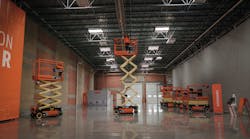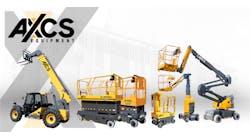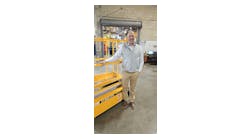RER: What impacts did COVID-19 have on your company as an aerial equipment manufacturer and on your customers?
Nerenhausen: As the COVID-19 health pandemic rapidly impacted the global economy, we took quick, decisive actions to protect the health and safety of our employees, our customers, and our business. Not unlike others, this was unchartered territory for us.
We made the decision early on to gear up for an unpredictable period, with a sharp eye on the long-term health of the business, which included protecting and retaining employees and managing supplier and customers relationships to sustain a reasonable inventory in preparation for an eventual recovery.
In what appears to now be the back end of the pandemic, this combination has proven successful. We were able to ramp up quickly when demand rebounded, without a sacrifice to the product quality or service customers expect from JLG.
The combination of focusing on our people, our suppliers and our customers, while remaining fiscally responsible, has resulted in company performance above what we’ve seen reported by others in the industry.
That said, we face continued uphill battles. Supply chain constraints continue to be a challenge and raw materials costs continue to climb. With the U.S. inflation rate hitting a 13-year high in recent weeks, both manufacturers and all those who are part of the rental industry ecosystem are experiencing unprecedented pricing pressures. We continue to work closely with both our suppliers and our customers to navigate this period with as little disruption and impact as possible.
What new equipment enhancements or developments has your company come up with in the past year?
We are always looking at ways to deliver greater value to our customers, and much of this comes through the introduction of new models with advanced features and technologies.
Some of our most recent product introductions include the world’s first all-electric scissor lift, the JLG DaVinci lift, as well as a completely redesigned line of engine and electric-powered rough terrain scissor lifts, two lightweight micro scissor lifts, the 1030P push-around lift, the eight-story lift height 1075 telehandler, the 2733 high-capacity telehandler and our smallest telehandler to date, the SkyTrak 3013.
In the boom category, we have introduced a full line of high-capacity models over the past year and will go into production with our 670SJ self-leveling boom lift this fall. We believe this self-leveling boom technology will be an industry game changer, much as the original boom lift developed by our founder John L. Grove did 52+ years ago.
I’ll talk a bit more about some of these products throughout my responses, but in this response, I’ll focus on how JLG is advancing ground level technology to improve operator comfort and safety at height.
Over the years, we have observed that working on uneven terrain is a common job site challenge. Some of our most recent product development efforts on JLG scissor lifts and boom lifts focused on finding solutions to help users work more confidently in these situations.
On boom lifts for example, self-leveling technology allows the machine to continuously and automatically level itself on slopes up to 10 degrees at full height. This eliminates the oftentimes cumbersome and time consuming need to grade the work area or crib the machine prior to beginning work, allowing the user to get closer to the work area quicker.
Our new RT/ERT Scissor Lifts feature LiftSense, a standard feature that shows an operator the maximum height they can achieve before elevating based on side-to-side and front-to-back tilt, as well as the current capacity in the platform, which removes the traditional guesswork that often results in having to descend and try again. Additionally, QuickLevel Advanced on RT scissor models automatically levels the machine on side slopes up to 4.5 degrees, while still allowing you to drive at full height under certain conditions.
All of these ground level features deliver tangible value to our customers through improved onsite efficiencies and safety enhancements, while eliminating customer pain points.
Any new safety enhancements or new safety products or accessories?
We talked about new product introductions above but didn’t touch on our connected solutions platform team. This team was founded in 2018 and is dedicated to developing technologies and applications that provide valuable data to facilitate business growth and advance job sites through sophisticated, yet simple-to-use technologies that seamlessly integrate with JLG machines and in some cases beyond the JLG product portfolio.
This level of perpetual innovation, like that of our founder, is driven by an insatiable curiosity and a drive for engineering excellence that empowers JLG to explore unchartered territory to develop the cutting-edge solutions, that when combined with equipment, improve the value stream for our customers and theirs.
Some of our latest rollouts from this platform team include JLG Mobile Control, our Augmented Reality App and our Advanced Battery Monitoring System (ABMS).
JLG Mobile Control offers remote control of select model scissor lifts through a mobile phone and the JLG Mobile Control App. Mobile Control allows the user to guide the stowed scissor lift from a distance with their phone, without the need to tether to the machine. This allows them to maneuver around obstacles, to position it into areas with low clearance and to load or unload it from a truck without the need for an operator in the platform or walking next to the machine.
Our downloadable Augmented Reality App has five modules including machine visualization, kit visualization, operational guidance, a decal viewer and inspection assistance. The visualization tools allow the user to choose the right equipment and/or accessory for the job by placing and moving a virtual machine or accessory onto a machine in an actual work environment. The operational guidance and decal viewer help users understand the machine controls and decals in their local language, while the inspection assistant provides historical inspection data specific to the machine.
And last but not least is our new Advanced Battery Monitoring System. This system provides concise, actionable data that fleet managers can use to ensure fewer worksite interruptions and improve project completion times. The new system, designed for electric scissors and boom lifts analyzes the machine's battery charge and usage, while providing superior diagnostic information on the battery and charger system. Components include a new Smart Charger, which logs the charge history and details on the machine controller, and a Mobile Control hardware module that provides wireless connectivity and interaction, allowing the user to access the data with a handheld analyzer tool or through the JLG Mobile Control App.
The continuous evolution of equipment through innovative, integrated technologies, will make MEWPs and telehandlers more intuitive to use and operate. These technology advancements will certainly play a part in building the next generation of brand loyalists, though core machine quality and productivity remains as important as ever.
There is more interest and growing in electric, battery-operated machines and other alternatives to diesel these days. What is your company’s strategy in regard to electric machines, electric drives, hybrids and alternative fuels?
We believe there will always be a place for engine powered scissor lifts, and while we don’t see IC powered lifts going away anytime soon, we are seeing an increase in demand for electric powered lifts. Impending Stage 5 engine regulations in Europe require a diesel particulate filter on all machines, which will add both cost and service complexity. This will further propel the momentum towards battery-operated machines.
You asked about our strategy regarding electric and hybrid machines. While we won’t disclose our strategy, we will say that our organization has been offering electric, battery-powered and hybrid lifts for decades, and we continue to be heavily vested in advancing electric technologies.
This is probably most evident in the release of our new DaVinci all-electric scissor lift, the first fully electric model of its kind. It is a progressive, environmentally friendly solution that comes just as demand is building for electrified products. Every component of the machine is optimized, allowing it to be powered with a single lithium-ion battery without a compromise to performance. It even recovers energy while the platform is being lowered, which contributes to a 70-percent decrease in power consumption and a longer battery life per charge. And it’s single lithium-ion battery is expected to last 120-plus months, so owners should never have to replace a battery during the machine’s lifespan.
Leak protection systems have been a positive development in recent years? Do you expect other similar safety features?
Leak protection systems are increasingly important, particularly when equipment is being used in environmentally sensitive work areas like clean rooms and data centers. JLG recently introduced its CleanGuard Leak Protection System offered as an option on select model scissor lifts. This environmentally friendly leak containment system features custom fit trays to capture leaks and drips from the power unit and the steer cylinder of a scissor lift, replacing the need to cover the underside of the machine with a diaper. CleanGuard does not interfere with operation or general servicing, is re-usable and blends in with the aesthetics of the machine.
But, we aren’t focused solely on leak containment. We’re focused on eliminating leaks altogether. Advancements in technology are allowing us to design and engineer products differently, allowing us to bring to market hydraulic-free products like the DaVinci all-electric scissor lifft. With its zero-hydraulics design, we eliminate potential leak points altogether. Leaks are one of the most frequent reasons behind scissor lift service calls. This type of technology has therefore been welcomed by customers. Anytime service requirements can be reduced without a loss to productivity in an environmentally responsible manner it’s a step forward for the industry.
One of the biggest responsibilities we have today as the access industry leader is to continually evolve and introduce solutions that allow customers to be more successful, safer and increasingly efficient on the job. Leak containment and elimination is certainly one part of this.
New ANSI standards have allowed larger loads on boom lifts. What other trends do you expect to see in the near future?
Some trends we are watching are urbanization, the rise of warehouse construction, data center growth and increasing demand for low-level access products.
On urbanization
Population growth and a larger percentage of families gravitating towards city centers is resulting in buildings that are taller with narrower space between them. With that, the demand for compact equipment, higher capacity machines and higher reaching models is on the rise. Our product development efforts are continuously evolving to ensure we have the solutions customers need to work in these areas.
On the compact side, we have entered the micro scissor category with our ES 1330 and ES 1530 scissors and have introduced the new 1030P low-level access lift for indoor use in place of ladders and scaffolding. In the telehandler category, we now offer an ultra-compact model, the SkyTrak 3013.
Looking at taller and higher capacity equipment, we recently introduced the JLG 1075 and 2733 telehandlers. The 1075, eight-story lift height, 60-ft reach telehandler eliminates the need for costly cranes, while the 2733, the largest and newest model in our high-capacity range, allow operators to pick and carry loads up to 26,600 pounds, minimizing the number of trips required to and from a loading area.
On warehousing
One only needs to drive down any major Interstate to observe the increase in warehouse construction. Going back even a few years, online shopping was not what it is today, and the pandemic further accelerated online demand. Warehouse construction often requires continuous placement of utilities at a fixed height along the length of a building. To match this application, JLG has designed its new RT and ERT line of scissor lifts with this capability.
On data centers
The world continues to become more and more connected. That means data center construction is also on the rise. Indoor work at data centers, requires lightweight, environmentally friendly machines that can be operated in confined areas or on suspended floors with weight restrictions and in between sensitive storage systems, servers and application delivery controllers. This is one type of application where our new DaVinci scissor lift shines.
On low-level access
Last, but certainly not at all least, is the increasing demand for low-level access products. These lifts are gaining in popularity as companies seek to mitigate worksite injuries associated with redundant movements and slips, trips or falls from ladders. While many manufactures seem focused on taller, higher reaching equipment, JLG is keeping an eye on both ends of the spectrum to provide people with safer ways to work at every height.
Widespread usage of telematics has been a positive development. What are some of enhancements your company has made in telematics and similar technology?
Telematics have been around for quite some time and in recent years, adoption rates have accelerated. We’ve learned that the amount of data these systems produce can easily overwhelm a customer and be rendered unusable if it’s not easily digestible or the person on the receiving end doesn’t have the time to analyze and action it.
Therefore, we are being asked to not only provide a means to collect and disseminate the data, but also a way to analyze and suggest actions based on the data to help users run a more efficient business. Raw data in and of itself is no longer enough. Customers want a full fleet of connected assets to optimize utilization, enhance worker safety and make machine operation more intuitive.
Take machine location for example. Today’s telematics can tell you where a machine is. Tomorrow’s telematics might give you more than the physical location. They may tell you the floor and exact location of the machine. And, when you get close, you might be able to easily identify the machine through an alert system, much like today’s “find my car” feature in on-road vehicles. So, in this instance, if a service call is required, telematics would no longer simply provide a machine location, it would lead the service tech directly to the machine.
Flexibility will be the cost of entry moving forward when it comes to telematics. The more seamless the data and information and the easier it is the action, the more valuable it will be to the customer. Taking the onus off the rental channel and its customers to analyze the data through predictive recommendations is the wave of the future.
We don’t want to give away too much, but we are definitely keeping an eye on the future of telematics and connected assets. We believe today’s telematics are a baseline for what’s to come, with holistic solutions on the horizon that will deliver the advanced options customers will require in the digital future.
Are there particular features that customers are asking for in the evolution of aerial equipment?
rental channel partners and end user customers always tend to have a wish list, and that can vary by region, by fleet makeup and by the type of work they complete. Despite regional differences, we do hear some common themes, most of which are related to integrated product technologies that will simplify machine operation and result in safer job sites.
The construction industry is typically a fast follower of the automotive industry. With that, we are seeing an increase in requests for sensor technology, cameras and alert systems and we are innovating to meet these needs.
SkySense is an enhanced detection system that uses strategically placed object detection sensors to provide operators an added level of awareness of their immediate surroundings. When a machine is in use, the sensors establish warning zones and stop distances in the machine’s direction of motion. As the machine approaches the zone limits, audible alerts notify the operator, increasing protection of people and property.
A Seatbelt Engagement and Operator Presence (SEOP) feature was recently unveiled for select model telehandlers. The system includes a high visibility orange seatbelt and functions by producing a visible and audible alarm whenever an operator is seated and unbuckled. For example, when the operator is seated with the vehicle ignition key on, alarms will be activated immediately and continuously if the seatbelt is not connected. The alarms will cease when the operator leaves the seat, turns the vehicle ignition off or connects the seatbelt. The alarms are intended to alert and remind the operator to buckle up for safety.
Camera systems are also on the rise. Our latest multi-reverse camera system for telehandlers uses cameras on the left, right and rear of the machine and a tri-view monitor in the cab to provide operators with greater visibility of their surrounds while backing up.
You start to see a common thread here throughout the answers. More and more, the evolution of equipment includes features made possible through the integration of new and emerging technologies that, when paired with a high level of after the sale support and service deliver a comprehensive solution to customers.
At JLG, we continue to focus on elevating the access industry in three areas: Productivity, safety and technology. None of these three things exist in a silo. We keep each one at the forefront of each and every product development effort.
While technology creates a lot of buzz in the media, the physical product itself, as well as parts and service support remain as important as ever. At JLG, we believe an appropriate combination of physical machine enhancements and digital connectivity are key to providing JLG owners and operators with the greatest long-term value.






